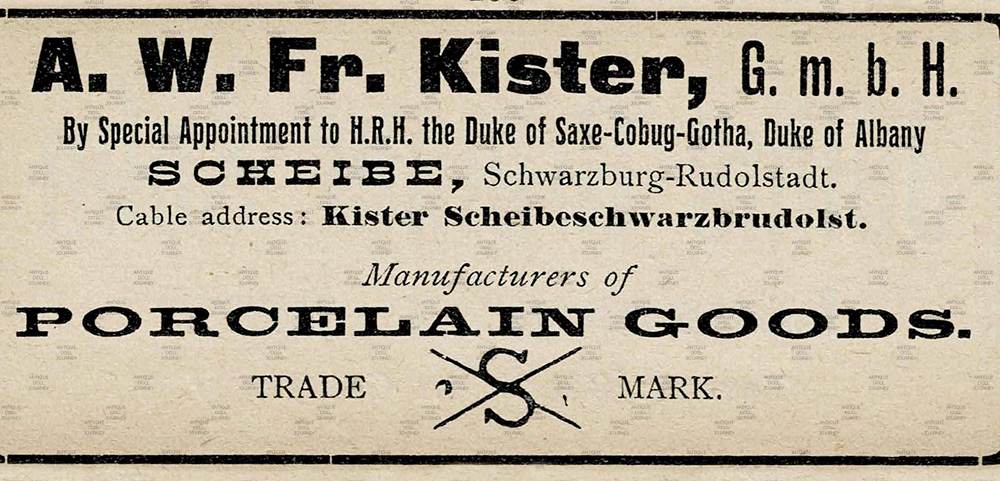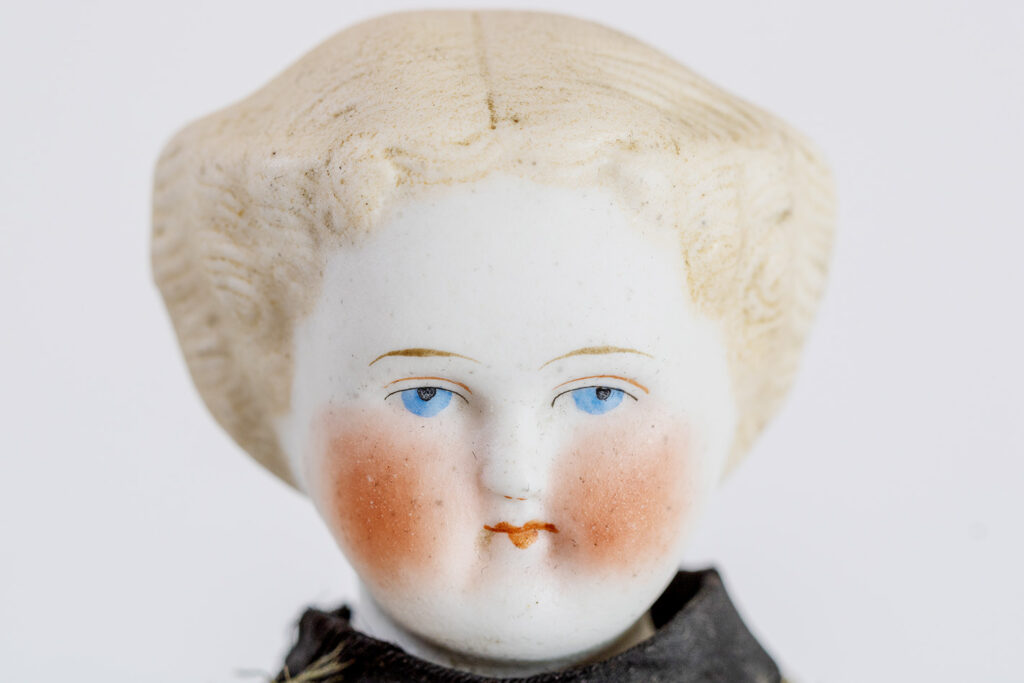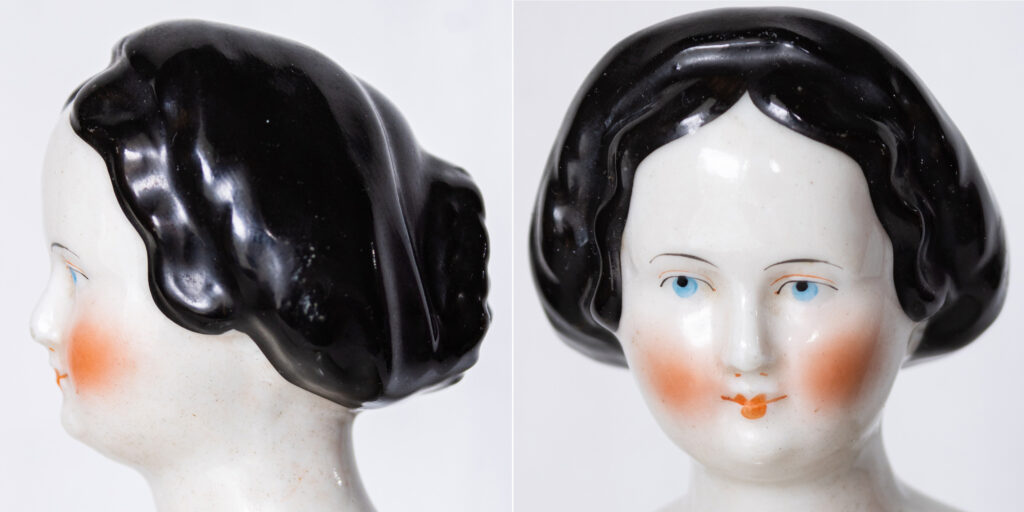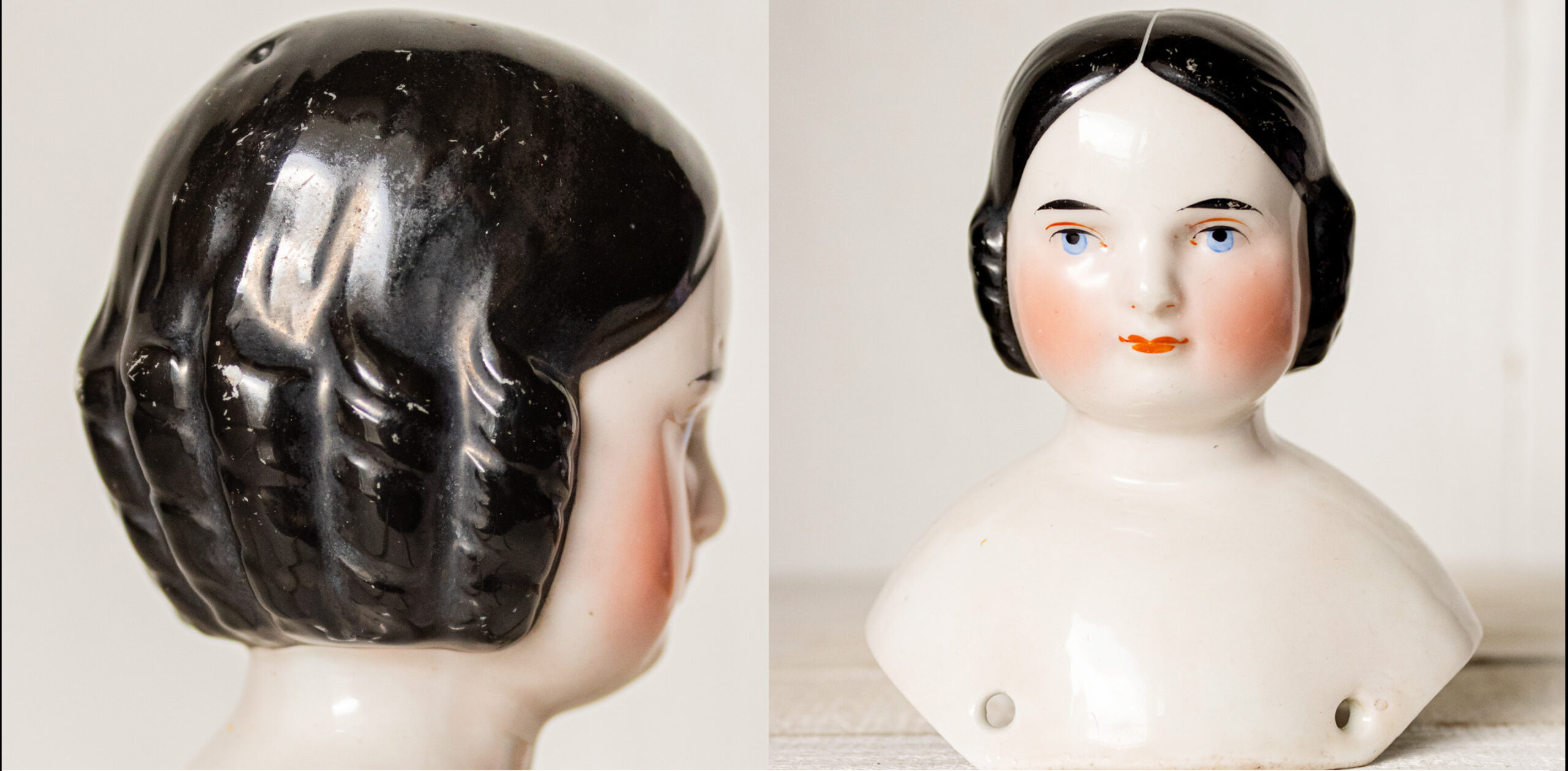Kister, a German porcelain manufacturers, identifies many collectible antique porcelain dolls from the 19th century / 1800s. Friedrich Kister was known to be the first of the German porcelain manufacturers to introduce Krench Kaolin in the making of porcelain.
Beginning of their Porcelain Factory
Different texts give varied information regarding the beginnings of the Kister porcelain factory. According to Mary Krombholz the factory began in the 1834 by Louis Oels, Daniel Kaempf, and Friedemann Greiner.
Johann Friedrich Kister, together with Dressel (Eisfeld) purchased the porcelain factory from Daniel Kampfe and Friedman Greiner around 1840. Kampfe and Greiner purchased the factory from Ludwig Oels in 1839. Oels had started the factory about 1835. By 1847 Kister and Dressel had about 148 workers. They claimed in the 1897 Leipzig Trade Fair Address Book that they existed since 1838.
In 1862 the German newspaper Passauer Zeitung reported that Friedrich Kister, living in Scheibe, Julius Hoffmann, and Wilhelm Lenk in Rosenau near Passau were joint owners of the porcelain factory in Rosenau near Passau under the open trading company: “Dressel, Kister & Comp.” with the Headquarters in Rosenau. The management of the factory was handled by Wilhelm Lenk.
The Passauer Zeitung (Lower Bavarian people’s newspaper) announced in 1863 that Friedrich Kister and Wilhelm Lenk, porcelain manufacturers, started their open business together on January 1, 1855 in Rosenau with Wilhelm Lenk holding exclusive authority to represent the company.
Friedrich Kister, porcelain factory owner in Scheibe died at the age of 57 after being sick for a long time (Passauer Zeitung, 1863 May 29, page 4). After his death only Julius Hoffman and Wilhelm Lenk remained as partners in the firm.
1875 Dissolution & Reorganization
In 1875 a newspaper provides a notice for the keeping of commercial registers that the company Dressel, Kister & Company was dissolved. Wilhelm Lenk is named the sole owner but continues to operate under the former name Dressel, Kister, & Co. This implies Julius Hoffman had left the company.
The German publication Sprechsaal in 1904 provided an ad listing for Dressel, & Kister & Co. showing three of their registered trademarks. The ad shows three different marks each naming “Dressel, Kister, & Co., Porzellanfabrik, Passau in Bayern.”
A. W. Fr. Kister
The publication Regel Fritz claimed that the company A. W. Fr. Kister was founded in 1888 under the company Dressel, Kister & Co. managed by Friedrich Kister until 1863 and then by Fridolin Kister beginning in 1876. The reporter wrote that the Kister porcelain factories in Limbach, Scheibe and Kazhütte produced mostly smaller or artistic objects worth transporting.
The German porcelain magazine Sprechsaal lists both A. W. Fr. Kister, founded in 1888 under the company of Dressel, Kister & Co. This indicates two separate Kister companies existing at the same time which causes confusion.
Kister Advertisements
In the German Ceramic Industry Address Book of 1906 the company advertised making fantasy articles, religious articles, tombstone figures, crockery, art foundries, and bronze pieces. Among the items they exported finely painted figures, jardinieres, flower holders, attachments, porcelain allegorical subjects, crucifixes, figures of saints, angels, cauldrons, and fireproof cookware. They boasted 300 workers with sample stores in Milan, Paris, Barcelona, London, Malaga, Selville, Cadiz, Grananda, Dublin, Amsterdam, and Copenhagen. In this advertisement they claim they existed since 1840.
Passauer Gold
The Kister porcelaine figurines received notice regarding some of the paint they used for decorating the figures. A reporter wrote in 1891, “Porcelain figurines in painted bisque had been brought by A. W. Fr. Kister-Scheibe, mostly terribly sweet in modeling and painting, but at least made captivating to non-connoisseurs by the well-known, terribly shiny ‘Passauer Gold.'”
1897 A. W. Fr. Kister Ad
Julius Fleishmann’s 1897 edition of the Buyer’s Guide through Germany starts by stating they were formerly called “Dressel, Kister & Co.” Then they give their address of Scheibe, Scharzburg-Rudolstadt with a cable address of Kister Scheibeschwarzburgrudolstadt. The ad then continues by saying they manufacture porcelain goods, artistically executed allegorical and mythical including figures, busts and groups. They made copies after Canova, Thorvaldsen and others. They had busts and statues of celebrated composers, poets, statesmen, etc. in the very finest white bisque and parian.
The Fleishmann ad continues to claim they manufacture fancy figures, busts and groups as well as swinging figures. Their goods included flower-holders, vases, centre-pieces, clocks and candelabras for candles and electrical purposes. They had mirrors, inkstands, ash- and card-receivers, easter goods, toothpick-holders, brooches and cuff-buttons, cork-stoppers with China tops, handles for Canes, Umbrellas and parasols in bisque and parian painted in various decorations from the simple to the most expensive ones also in Meissen style.
The Kister’s claimed a specialty in old ivory decorations on handfinished goods as well. They also carried religious goods such as figures of saints, crucifixes, and holy-water vessels along with ornaments for grave stones such as figures, angels, wreaths, etc. in great variety in bisque and parian.
At the bottom of the ad one finally reads about their toys, animals, single and by families along with dolls’ heads, swimming dolls, all jointed babies, etc. Their they then boast of first awards at all expositions: gold medals in Chicago and San Francisco being represented in Hamburby by Messrs. Meyer & Schmitz and in Berlin by Messrs. Schroder & peltzer.
At the bottom of the ad is the K.P. M. trademark of a simple X. (This may be confused with the Carl Krister trademark found in the 1901 Sprechsaal issue. See here.)
That year the company also advertised, “A. W. Fr. Kister, Scheibe, Schw.-Rud. Auerbachs-Hof No. 57. Classic figures, busts, groups made of the finest white biscuit porcelain. Medallions, flower holders, vases, centerpieces, clocks, candlesticks, night lamps, retouched figures etc. in old ivory and colorful decorations. Vases and flower holders with and without figures in the secession style. Gravestone decorations, cane handles, fittings, doll heads. Bathing children, articulated dolls, free-standing dolls etc.”
1897 Leipzig Trade Fair
The Leipzig Trade Fair Address Book for 1897 gave this listing for Kister: “A. W. Fr. Kister, formerly Dressel, Kister & Co., Scheibe (Schwarzburg-Rudolstadt), porcelain factory and painting, manufactured goods: luxury and holy items, dolls, toys – O.-V. Auerbachs Hof, Gewölbe 57. Existed since 1838. Awarded at all exhibitions attended, most recently with the gold medal in Chicago and San Francisco.”
1906 A. W. Fr. Kister Ad
The 1906 address book also lists the A. W. Fr. Kister company. The listing says the porcelain factory lies in Scheibe with Paul Kister and G. Offeney as owners of the G. m. b. H. company.
In this listing the A. W. Fr. Kister Factory claims they manufacture for domestic and export. Items listed are luxury items, fancy goods, and toys such as: white bisque figures, groups, busts, Easter items, candy boxes, night lamps, birds, toothpick holders, boxes, holy figures, votive cauldrons, crucifixes, etc., in porcelain and parian mass. Fittings for gas and electric lighting, for confectioners and perfumers. Free-standing animals, bath babies and articulated dolls, doll heads, cane and umbrella handles, cufflinks, brooches and pins in imitation ivory.
They claimed to make retouched figures, busts, old ivory and colored ivory decorations. With 200 workers they had representatives with warehouses in Berlin, Hamburg, Vienna, Paris, London, New York., Brussels, Copenhagen, Amsterdam, Milan, Madrid, Lisbon, Barcelona, Palermo, and Smyrna. Their listing claims they won gold medals in Weimar 1861, Porte Allegre in 1881; Douglas (Isle of Man) in 1892, Chicago in 1893, in San Francisco in 1894, in Brussels in 1897 with the gold medal, and in St. Louis in 1904. –
This listing claims this company had existed since 1838. They display a trademark with an S with two lines crossing through it. Below it shows the trademark initials K. P. M.

1897 Leipziger Mess-Adressbuch
The address book of the Leipzig Trade fair in 1897 listed them as “Dressel, Kister & Co.” providing the information as “Passau (Bayern), Porzellan-, Steingutund Majolika-Fabrik. O.-V. Auerbachs Hof, Tr. C, II” (porcelain, earthenware and majolica factory.)
1911 Ad in German Buyer’s Guide
A full page ad appeared in the 1911 Kister advertised as “A. W. Fr. Kister, G. m. b. H. by Special Appointment to H.R.H. the Duke of Saxe-Coburg-Gotha, Duke of Albany SCHEIBE, Schwarzburg-Rudolstadt. Cable address: Kister Scheibeschwarzbrudolst.
The ad claimed they manufacturered of porcelain goods which were artistically executed allegorical and mythical figures, busts and groups (copies after Canova, Thorvaldsen etc.). They also listed busts and statues of celebrated composers, poets, statesmen, etc. in the very finest white bisque and parian. Other items listed were fancy figures, swinging figures, flower-holders and vases (in new art and other styles), centre-pieces, clocks, paper-weights, Easter goods, bonbon-boxes, night-lamps, toothpickholders, birds, grotesque figures and animals as well as handles for canes, umbrellas, and parasols.
The ad claimed a specialty of figures, busts etc with old ivory, old sevres and underglaze decorations in the very best finish along with religious goods such as figures of saints for all countries; guardian angels, crucifixes, and holy-water-fonts. Interestingly they also mention ornaments for grave stones such as figures, angels, doves, etc in great variety of bisque and parian.
Of course along with all the other items the ad mentions TOYS: animals, single and in families; and dolls’ heads, swimming dolls, all jointed bisque babies in endless variety.
The ad ends with mentioning their gold medal from the exhibition in Chicago, San Francisco, Brussels, Milan in 1906 and in St. Louis. They mention a location of “Handelshof” at the Leipsic fair in room 86 on the first floor.
The ad shows the trademark at the bottom of the letter S with the large X crossing out the S.
Kister Porcelain Marks
One Kister mark identified shows the capital letters K. P. M. with an X underneath and a similar one with the letters K. P. F. According to Porzellanmanufaktur Scheibe-Alsbach G.m.b.H. there are no known marks for the era of time the company was called Dressel, Kister & Co. Later marks have a S marked with a X over it.
Doll Facial Features
Most Kister porcelain doll heads have blue irises without outlines or highlights. They will normally have red strokes painted above the eyes, red dotted nostrils, and single stroke eyebrows. Laster porcelain doll heads have an oval shaped lower lip.
Hairstyles found on Kister Porcelain Dolls
Mary Krombholz, who studied the porcelain shards found under the floorboards of the factory, claimed that the porcelain heads with molded hair buns from the 1840s were some of the finest products of the factory. Some of these were known as “Lydia” hairstyles. One of the early Kister doll heads from the 1840s had a Queen Victoria hairstyle with the hair looped under the ear. During these years the dolls had jointed wooden bodies or cloth bodies with porcelain lower arms and legs.
During the 1850s porcelain doll heads have hairstyles known as the Covered Wagon, Sophia Smith, and Kinderkopf.

In the 1860s the factory made doll heads with more flat top hairstyles and vertical curls. In the 1860s some hairstyles resembled that of Jenny Lind, a famous Swedish opera singer, with a low bun in the back.

She has the typical oval style bottom lip.

(This doll is glazed and therefore called a “china head doll.”)
The doll heads transition into rather fancier or even extravagant hairstyles in the 1870s. Hairstyles shown above also appeared on dolls made by other companies such as Kestner and Alt, Beck & Gottschalck.
See more about other German antique dolls here.
